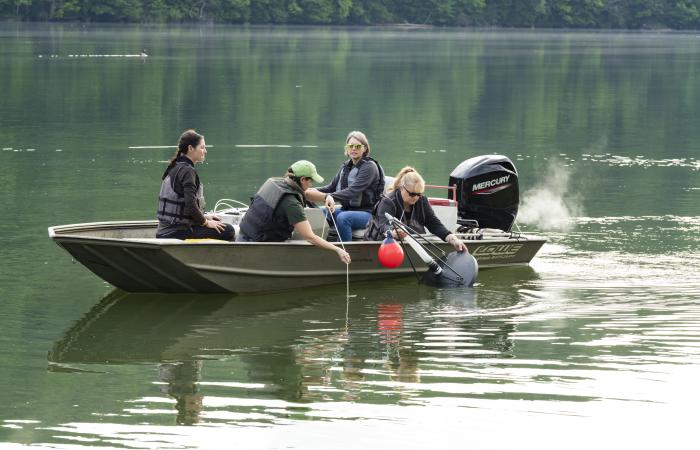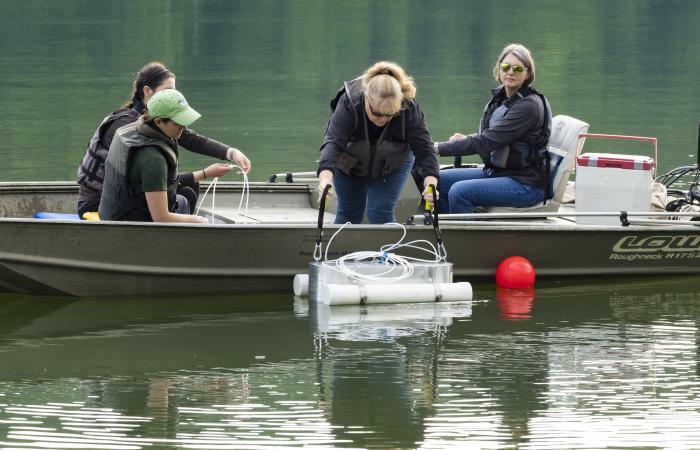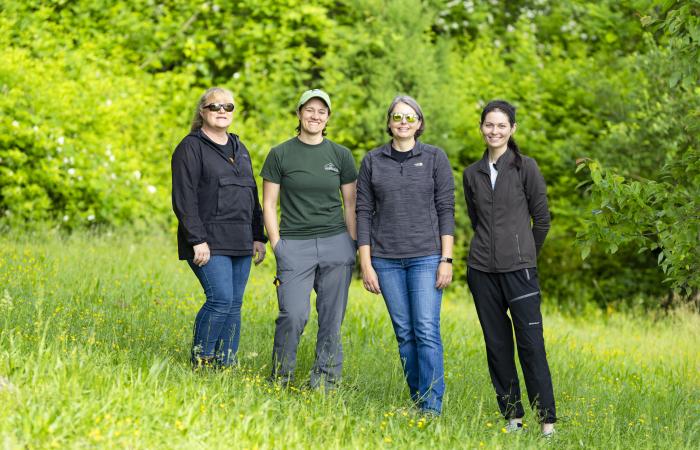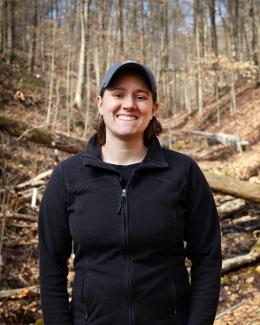As the United States moves toward more sustainable and renewable sources of energy, hydropower is expected to play a pivotal role in integrating more intermittent renewables like wind and solar to the electricity grid because hydropower can fill gaps in generation when these forms of energy are unavailable.
Before the hydropower sector can fully realize its benefits to the national power grid and the environment, more must be understood about the greenhouse gas, or GHG, emissions from reservoirs. Current reservoir emission estimates are highly variable, uncertain and incomplete. At the global scale, estimates can vary significantly and currently range from 0.14% to 6.6% of global GHG emissions.
Researchers at the U.S. Department of Energy’s (DOE) Oak Ridge National Laboratory (ORNL) are combining statistical modeling with advanced field methods, including drone technology, to more accurately assess GHG emissions from hydropower reservoirs.
Emissions are currently estimated by conducting field measurements, but with approximately 1,400 reservoirs that support hydropower generation across the nation, few have been sampled and even fewer, if any, are monitored regularly. This, combined with inconsistently applied methodologies and types of emission pathways studied, has resulted in spotty and uncertain results.
To make up for such a limited amount of field data, hydropower operators must rely on online modeling tools to broadly define the GHG footprints of their projects. However, emission figures are only as good as the underlying models, which themselves are developed based on field data.
Adding to the confusion is the fact that reservoirs often have multiple uses, including drinking water and flood control. So, attributing all reservoir GHG emissions to hydropower can be inaccurate.
“We’re committed to putting sound science behind the search for more accurate greenhouse gas emission estimates,” said Natalie Griffiths, research scientist in ORNL’s Environmental Sciences Division.
With funding from DOE’s Water Power Technologies Office, the ORNL project team will return to the sites of six hydropower reservoirs they sampled in the southeastern U.S. a decade ago.
Using more advanced measurement tools at each reservoir, the team will compare their findings to those from 10 years ago and to current model projections. The new assessment techniques are expected to provide greater resolution and explanation of variability, leading to more accurate models — all of which may shed light on potential mitigation efforts to further reduce emissions.
Understanding the pathways of GHG emissions
GHGs are emitted from all inland waters because of microbes in the sediment that naturally produce either carbon dioxide or methane. The ORNL research team will assess carbon dioxide emissions but will focus primarily on methane emissions, which have been understudied and pose a global warming potential 30 times higher than carbon dioxide.
The three most common pathways for GHG emissions from reservoirs are diffusion, ebullition and degassing. In diffusion, microbes in the sediment churn and release GHGs to the water surface. Warmer temperatures increase this rate of release. In ebullition, or bubbling, methane becomes trapped in bubbles, and if those bubbles rise to the water surface, the methane is emitted to the atmosphere. This bubbling pathway occurs primarily in shallow waters where methane bubbles are closer to the surface and therefore have less time to dissolve. Once on the surface, it can be released into the atmosphere or converted into carbon dioxide. Degassing occurs when reservoir water is passed through a pumphouse via hydropower turbines, or through flood control spillways. If deep water, which often contains higher methane concentrations than shallower water, is pulled through turbines, this can increase the chance of releasing methane downstream.
While previous reservoir emission assessments have tracked one or more of these pathways, the ORNL study marks one of the few times that all three GHG emissions are being measured simultaneously.
Better data — in the field and in the models
As the climate continues to warm, environmental factors and processes that influence GHG emissions are also expected to change. Models can help provide insight in these changing times.
“We can’t go back in time to see how things were in a really dry year or a really wet year or under different operational conditions, and we can’t sample every reservoir. But models can help us better understand emissions under varying conditions,” said Carly Hansen, water resources engineer at ORNL. “Through good data and statistical modeling, we can uncover the true drivers of greenhouse gas emissions.”
To help identify patterns and trends that influence GHG emissions now and in the future, ORNL researchers are using the International Hydropower Association’s G-Res model—a web-based tool to assess the carbon footprint of a reservoir. By analyzing the sensitivity of reservoir emissions to influences such as local climate variability and dynamic reservoir operations, the research team is working to identify gaps in knowledge and data to enable more accurate field measurements.
With statistical analyses in hand, the team is designing a plan that specifically defines exactly where measurements should be taken at the revisited reservoirs to capture a more representative estimate of GHG emissions.
In the field, ORNL researchers will continue to measure carbon dioxide and methane emissions throughout the year in these reservoirs located in Tennessee, Alabama, Georgia, North Carolina and South Carolina. The team will use a variety of standard and new measurement techniques, including a gas diffusion chamber, gas traps and an aquatic drone. The drone — a remote-controlled boat equipped with a suite of sensors — can collect measurements more efficiently than traditional sampling methods.
These higher-resolution data will inform improvements to the GHG emissions models with the aim of using the models to better predict emissions from existing and new hydropower reservoirs.
The ORNL research team is also working with the Environmental Protection Agency’s (EPA) national reservoir emission survey to compare GHG emissions from hydropower reservoirs to those formed by non-powered dams. The agency’s Survey of Reservoir Greenhouse Gas Emissions project is measuring GHG emissions at 108 U.S. reservoirs, including some hydropower reservoirs, across a variety of geographical regions, reservoir depths and biological conditions.
Over the long term, these new approaches and tools could reduce the variability and uncertainty seen in previous GHG emission estimates and lead to more informed reservoir management with the goal of mitigating GHG emissions while generating hydropower for a resilient national grid.
UT-Battelle manages Oak Ridge National Laboratory for DOE’s Office of Science, the single largest supporter of basic research in the physical sciences in the United States. DOE’s Office of Science is working to address some of the most pressing challenges of our time. For more information, visit energy.gov/science. — Mimi McHale










